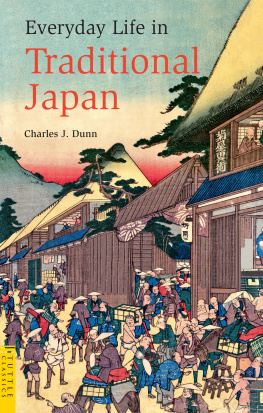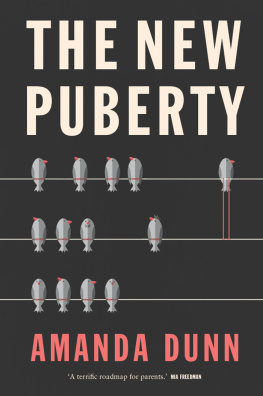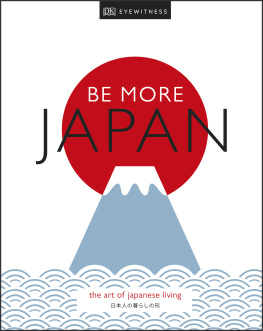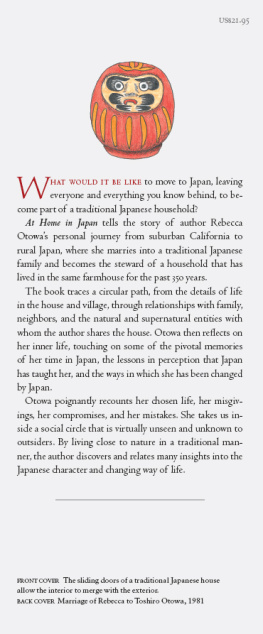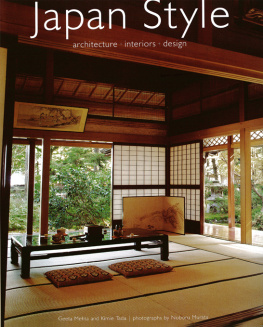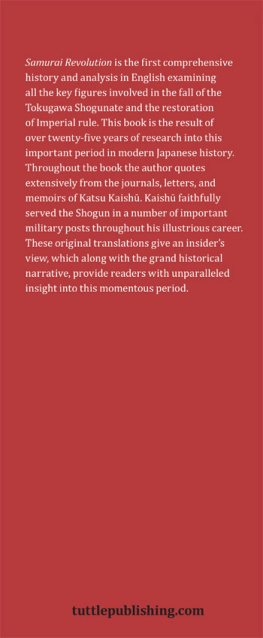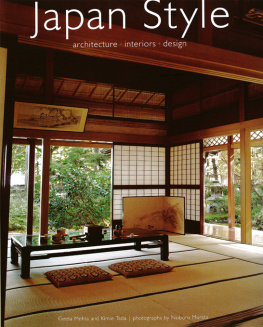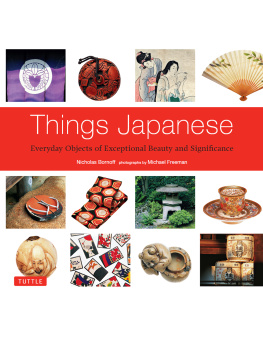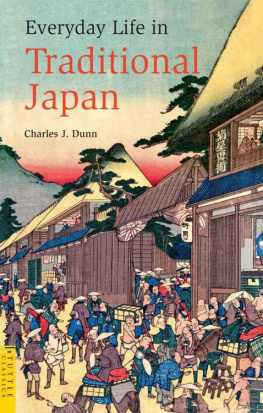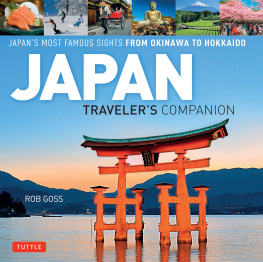ACKNOWLEDGMENTS
The author and publishers would like to thank the following for the illustrations appearing in this book: Hyogensha Co. Ltd, Kyoto for fig..
A country in isolation
The Land
Being at the eastern end of the Asian continental mass, Japan has a climate in many ways like that of the Northern Atlantic states of the USAthat is to say, winters are cold (with winds blowing from Siberia), and summers are hot (with winds from the Pacific). The cold winds of winter cross the Japan Sea before reaching the mountainous continent-facing coast of Japan, and as they do so they pick up moisture; much of this is deposited as snowfall, which is consistently heavy, often coming up to the eaves of the houses ( ). The Pacific side of Japan tends to have bright but cold weather in winter. In summer, the continent-facing side has clear weather, while there is cloud on the Pacific coast, so that, particularly in the south and east, summers are hot and humid. The Japanese find the heat of their summers more unpleasant than the winter cold, and build their houses accordingly.
Japan consists of four main islands, with innumerable smaller ones. The northernmost is Hokkaid, which was not sufficiently populated during our period to be of importance. To the south is Honsh, the main island, somewhat larger than Great Britain, with Kysh and Shikoku lying further south still ( ) are usually distant from areas of population and damage from eruptions has not been great, earthquakes are part of everyday life, with small shocks constantly reminding the Japanese that disaster could occur at any moment.
On the favorable side of her geographical position, Japan has a low latitude, with the sun higher in the sky and with less variation in length of day than in northern Europe. Winter is short, and so the growing season is long. Warmth and moisture together with fertile alluvial soils in most of the agricultural districts help to make Japan rich in food-crops ( ), which meant that in our period building was of wood; houses were made of cedar and other durable timber, needing no paint, but very inflammable, so that fires might easily sweep away whole villages or sections of towns if the wind were right. When an earthquake came, however, the frame houses were pliable and less likely to collapse than if they had been more solidly built of brick or stone.

(3) Snow scene. This photograph has some television aerials and electric wires, but otherwise gives a good impression of a traditional Japanese scene after a moderate snowfall.
The People
In common with most of the other inhabitants of the Asian Pacific littoral, the modern Japanese are classified as Mongols, but there seem to be several strains in the population. It is most probable that there has been a mixture of people coming from Korea and North China, from South China, and from the islands of the Pacific, through the Ryky Islands. There are indications that some elements of Japanese culture are derived from the south; domestic architecture, for example, may have some connection with that of Polynesia.
The Japanese language, even though it has certain similarities of structure with some continental Asian languages like Korean and Mongolian, cannot be shown to have a common descent with them, and the only clearly related language is that of the Rykys. The sole extraneous ethnic group is formed by the Ainus, now restricted to the island of Hokkai in the north; they had all gone from the mainland of Japan long before the seventeenth century, and certain place-names, including that of Mt Fuji, are the only relics of their earlier, far wider, occupation, before they were driven out by their successors, the people who, free from invasion themselves, forged a strong and homogeneous culture, going back some 2,000 years.

(4) The crater of Mt Aso. This volcano, in Kyushu, is still active.
The native Japanese religion, now called shint , the way of the gods, has some elements that may derive from the shamanism of northern Asia, but it also includes simple animistic cults, in which trees and rocks, sometimes whole mountains or islands, are worshipped ( ). It had as its culmination a set of creation-legends, which include an account of the divine origins of the Imperial family.

(5) Flooded rice-fields, with terracing on the left. The wide, straight roads are, of course, modern.
One important sector of shint is concerned with food-production and fertility, rice-wine and jollity. Shint is also very preoccupied with cleanliness and the avoidance of defilement, and prefers not to have anything to do with death. On the other hand Buddhism, which came to Japan from China through Korea some 1,500 years ago, brought with it, along with glamorous elements of Chinese civilization and artistic achievement, a new introspection and withdrawal from the world, a concern with the afterlife and an acceptance of death ( ).

(6) Forest of sugi, a large tree, like the cedar, near Kyoto, the old capital.
For many centuries these two religions had been complementary: the gods of shint were incorporated into the Buddhist system, even though the two priesthoods and the centers of worship, Buddhist temples and shint shrines, usually retained their independence. Between them the two religions provided, and to a large extent still provide, a background for almost all human activity in Japan, but only a background, not a morality. Morality, the rules of conduct within society, was defined in secular principles, largely derived from Confucianism. These principles included a system of loyalties, in which ones lord came before ones family, and parents before spouse and children, together with an unquestioning acceptance of authority. Sobriety and frugality were required of superior men, while extravagance, whether in dress, emotion, or expenditure, was to be deplored, although no more than could be expected from the lower classes, especially from those whose aim was the amassing of money, rather than service to ones lord or ones country. Although the money motive is less reprehensible today, these attitudes are still to be found among the Japanese, and are demonstrated in loyalty to their employers and to their country.

(7) Miyajima, with its outer gate ( torii ) set in the sea. The whole island, of which some is visible on the left, used to be worshipped as a god, and women and agriculturalists were not allowed on it.
The End of Civil War
Since the twelfth century, when the old rule by the emperor or his courtiers had been replaced by that of military overlords, there had been periodical civil wars in Japan, either between opposing clans or factions, or sometimes involving an emperor trying to regain the authority that his ancestors had enjoyed. These wars had hindered the development of trade, had been an ever-recurring danger to crops, and had depleted the countrys manpower. It is true that a certain amount of literature had been produced, but it was concentrated in the Imperial and military courts and great religious centers. N plays, the tea ceremony and its equipment, the reformation of poetry that led to the 17-syllable haiku , all owe their development to this period, but all were restricted to small aristocratic and religious circles.

